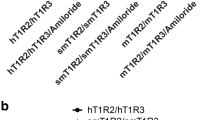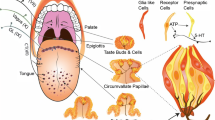Abstract
The human sweet taste receptor is a TAS1R2/TAS1R3 heterodimer. To investigate the correlation between the in vitro affinity of sweeteners with stably expressed human sweet taste receptor in HEK-293 cells and human sensory evaluation, the receptor-ligand activity of bulk (sucrose, D-fructose, and allulose) and high-intensity sweeteners (saccharin, rebaudioside A, rebaudioside M, and neohesperidin dihydrochalcone) was compared by analyzing the Ca2+ release. The relative potency of the sweeteners was identified over a wide concentration range for EC50s. Relative to sucrose, bulk sweeteners showed similar concentration ranges and potency, whereas high-intensity sweeteners exhibited lower concentration ranges and higher potency. The log of the calculated EC50 of each sweetener relative to sucrose by the in vitro affinity assay was positively correlated (r = 0.9943) with the molar relative sweetness reported in the previous literatures. These results suggested a good correlation between the in vitro activity assay of sweeteners and human sensory evaluation.



Similar content being viewed by others
References
Adler E, Hoon MA, Mueller KL, Chandrashekar J, Ryba NJ, Zuker CS. A novel family of mammalian taste receptors. Cell. 100: 693-702 (2000)
Ahn SR, An JH, Song HS, Park JW, Lee SH, Kim JH, Jang J, Park TH. Duplex bioelectronic tongue for sensing umami and sweet tastes based on human taste receptor nanovesicles. ACS Nano. 10: 7287-7296 (2016)
Baghirova S, Hughes BG, Hendzel MJ, Schulz R. Sequential fractionation and isolation of subcellular proteins from tissue or cultured cells. MethodsX. 2: 440-445 (2015)
Bassoli A, Laureati M, Borgonovo G, Morini G, Servant G, Pagliarini, E. Isovanillic sweeteners: sensory evaluation and in vitro assays with human sweet taste receptor. Chemosensory Perception. 1: 174-183 (2008)
Behrens M, Blank K, Meyerhof W. Blends of non-caloric sweeteners saccharin and cyclamate show reduced off-taste due to TAS2R bitter receptor inhibition. Cell Chemical Biology. 24: 1199-1204 (2017)
Carakostas MC, Curry LL, Boileau AC, Brusick DJ. Overview: the history, technical function and safety of rebaudioside A, a naturally occurring steviol glycoside, for use in food and beverages. Food and Chemical Toxicology. 46: S1-S10 (2008)
Chandrashekar J, Hoon MA, Ryba NJ, Zuker CS. The receptors and cells for mammalian taste. Nature. 444: 288-294 (2006)
Chaudhari N, Roper SD. Review series: the cell biology of taste. Journal of Cell Biology. 190: 285-296 (2010)
Chung MY, Oh DK, Lee KW. Hypoglycemic health benefits of D-psicose. Journal of Agricultural and Food Chemistry. 60: 863-869 (2012)
Colonna WJ. Samaraweera U, Clarke MA, Cleary M, Godshall MA, White JS. Sugar. Vol 19. pp. 1–67. In: Kirk‐Othmer encyclopedia of chemical technology. Wiley, New York, NY, USA (2000)
DuBois GE. Molecular mechanism of sweetness sensation. Physiology and Behavior. 164: 453-463 (2016)
Featherstone S. Ingredients used in the preparation of canned foods. 4th ed. Woodhead, UK. pp. 147-211 (2015)
Fernstrom JD, Munger SD, Sclafani A, de Araujo IE, Roberts A, Molinary S. Mechanisms for sweetness. Journal of Nutrition. 142: 1134S-1141S (2012)
Goyal SK, Samsher, Goyal RK. Stevia (Stevia rebaudiana) a bio-sweetener: a review. International Journal of Food Sciences and Nutrition. 61(1): 1-10 (2010)
Hellfritsch C, Brockhoff A, Stähler F, Meyerhof W, Hofmann T. Human psychometric and taste receptor responses to steviol glycosides. Journal of Agricultural and Food Chemistry. 60: 6782-6793 (2012)
Horowitz RM. Gentili B. Dihydrochalcone derivatives and their use as sweetening agents. U.S. Patent 3,087,821 (1963)
Kemp SE, Lindley MG. Developments in sweeteners for functional and speciality beverages. Woodhead, UK. pp. 39-54 (2009)
Kim SK, Chen Y, Abrol R, Goddard WA, Guthrie B. Activation mechanism of the G protein-coupled sweet receptor heterodimer with sweeteners and allosteric agonists. Proceedings of the National Academy of Sciences. 114: 2568-2573 (2017)
Kinghorn AD, Chin YW, Pan L. Jia Z. Natural products as sweeteners and sweetness modifiers. Vol 3. pp. 269–315 In: Comprehensive Natural Products II: Chemistry and Biology. Mander L, Liu HW (Ed). Elsevier., Oxford, UK (2010)
Lagerström MC, Schiöth HB. Structural diversity of G protein-coupled receptors and significance for drug discovery. Nature Reviews Drug Discovery. 7: 339-357 (2008)
Li J, Ning Y, Hedley W, Saunders B, Chen Y, Tindill N, Hannay T, Subramaniam S. The molecule pages database. Nature. 420: 716-717 (2002a)
Li X, Servant G. Functional characterization of the human sweet taste receptor: high-throughput screening assay development and structural function relation. ACS Symposium Series. 979: 368-385 (2008)
Li X, Staszewski L, Xu H, Durick K, Zoller M, Adler E. Human receptors for sweet and umami taste. Proceedings of the National Academy of Sciences. 99: 4692-4696 (2002b)
Nelson G, Hoon MA, Chandrashekar J, Zhang Y, Ryba NJ, Zuker CS. Mammalian sweet taste receptors. Cell. 106: 381-390 (2001)
Njoman MF, Nugroho G, Chandra SDP, Permana Y, Suhadi S, Mujiono M, Hermawan AD Sugiono S. The vulnerability of human sensory evaluation and the promising senses instrumentation. British Food Journal. 119: 2145-2160 (2017)
Parker K, Salas M, Nwosu VC. High fructose corn syrup: production, uses and public health concerns. Biotechnology and Molecular Biology Review. 5: 71-78 (2010)
Prakash I, Markosyan A, Bunders C. Development of next generation stevia sweetener: Rebaudioside M. Foods. 3: 162-175 (2014)
Priya K, Gupta VRM, Srikanth K. Natural sweeteners: a complete review. Journal of Pharmacy Research. 4: 2034-2039 (2011)
Song HS, Jin HJ, Ahn SR, Kim D, Lee SH, Kim UK, Simons CT, Hong S, Park TH. Bioelectronic tongue using heterodimeric human taste receptor for the discrimination of sweeteners with human-like performance. ACS Nano. 8: 9781-9789 (2014)
Spakman D. How to broaden the applicability of the high potency sweeteners steviol glycosides: from enzymatic glycosylation to recombinant production. Groningen Biomolecular Sciences and Biotechnology Institute, Groningen, Netherlands pp. 1-21 (2015)
Surana SJ, Gokhale SB, Rajmane RA, Jadhav RB. Non-saccharide natural intense sweeteners–an overview of current status. Natural Product Radiance. 54: 270-278 (2006)
Tiefenbacher KF. The Technology of Wafers and Waffles I: Operational Aspects. Academic Press, Oxford, UK pp.123-225 (2017)
Xu H, Staszewski L, Tang H, Adler E, Zoller M, Li X. Different functional roles of T1R subunits in the heteromeric taste receptors. Proceedings of the National Academy of Sciences. 101: 14258-14263 (2004)
Yebra-Biurrun MC. Food and Nutritional Analysis | Sweeteners. Vol 3. pp. 471–481. In: Encyclopedia of Analytical Science. Worsfold P, Townshend A, Poole C, Miró M (Eds). Elsevier., Oxford, UK (2013)
Zhao GQ, Zhang Y, Hoon MA, Chandrashekar J, Erlenbach I, Ryba NJP, Zuker CS. The receptors for mammalian sweet and umami taste. Cell. 115: 255-266 (2003)
Acknowledgement
This research was supported by the National Research Foundation of Korea (NRF) (2017R1A2B4011593), the Korea Institute of Planning and Evaluation for Technology in Food, Agriculture, and Forestry (IPET) through Innovative Food Product and Natural Food Materials Development Program, funded by Ministry of Agriculture, Food and Rural Affairs (MAFRA) (119020-03-2-HD040), and Brain Korea 21 Plus (Project Number: 22A20130012143).
Author information
Authors and Affiliations
Corresponding author
Ethics declarations
Conflict of interest
The authors have no conflict of interest to declare.
Additional information
Publisher's Note
Springer Nature remains neutral with regard to jurisdictional claims in published maps and institutional affiliations.
Rights and permissions
About this article
Cite this article
Choi, Y., Manthey, J.A., Park, T.H. et al. Correlation between in vitro binding activity of sweeteners to cloned human sweet taste receptor and sensory evaluation. Food Sci Biotechnol 30, 675–682 (2021). https://doi.org/10.1007/s10068-021-00905-z
Received:
Revised:
Accepted:
Published:
Issue Date:
DOI: https://doi.org/10.1007/s10068-021-00905-z




